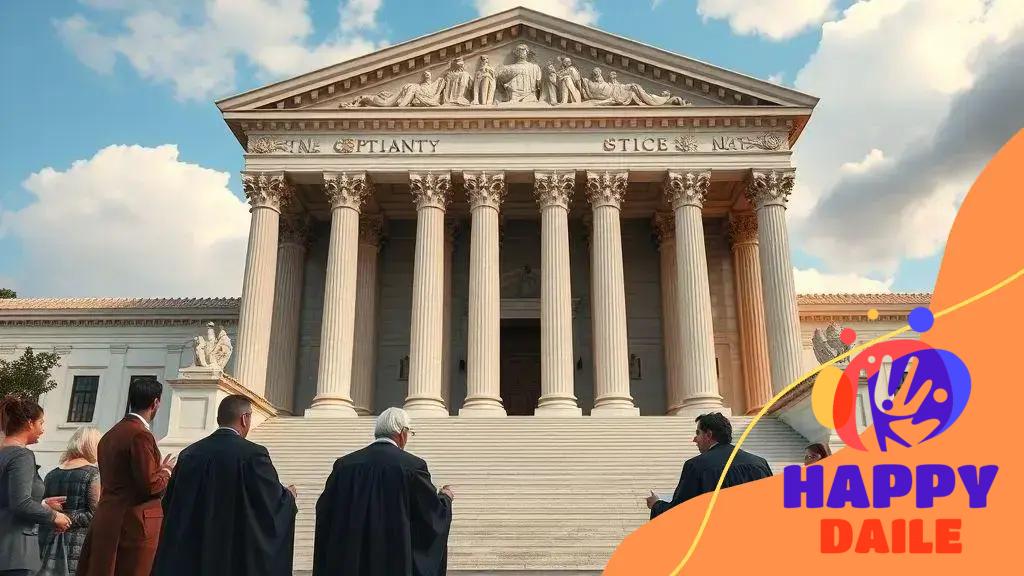Supreme Court tie vote: What it means for justice

Anúncios
A Supreme Court tie vote occurs when justices are evenly split on a case, leading to the preservation of lower court rulings and reflecting significant divisions on contentious legal issues.
A Supreme Court tie vote can have profound implications for justice and legal precedent.
Anúncios
It raises questions about the balance of power and how decisions are made. What happens next when the court is deadlocked?
Understanding Supreme Court tie votes
Understanding supreme court tie votes is essential for grasping how the highest court in the United States operates.
These votes occur when the justices are evenly split on a case, resulting in important decisions being left unresolved.
What causes a tie vote?
Several factors can lead to a tie vote. One primary reason is the absence of a justice during the voting process.
Anúncios
This can happen due to various reasons, such as health issues or recusal from the case.
Impact of tie votes
When the court reaches a tie, the lower court’s decision typically stands. This can have significant implications, especially for cases that deal with controversial issues. Here are some potential impacts:
- The status quo remains unchanged.
- Lower court decisions are upheld, setting regional precedents.
- Legal uncertainty may arise as conflicting rulings exist across different courts.
A tie vote doesn’t simply halt progress; it can also highlight differing judicial philosophies among the justices.
Some justices might lean more conservatively, while others adopt a liberal stance, showcasing the ideological divides within the court.
Furthermore, tie votes can spark debates about the nominations and confirmations of justices. The composition of the court plays a crucial role in how cases are decided.
Consequently, understanding Supreme Court tie votes requires looking beyond the votes themselves to the broader context of judicial politics.
Historical significance of tie votes
The historical significance of tie votes in the Supreme Court is profound.
These occurrences don’t just represent indecision; they reflect deep divisions in legal interpretations and societal values over time.
When the court is deadlocked, it can leave crucial issues unresolved, impacting the law and public policy for years.
Major tie votes in history
There have been several notable tie votes throughout history. Each one has shaped the judicial landscape in its own way. Some significant cases have included:
- Hardwick v. Georgia, which addressed sodomy laws.
- United States v. Nixon, during the Watergate scandal.
- Whole Woman’s Health v. Hellerstedt, pivotal for abortion rights.
Each of these cases highlights the critical role that tie votes can play. They often showcase ideological divides that parallel societal debates.
As the courts grapple with complex issues, tie votes can halt progress. For example, a tie in a high-profile case can lead to confusion about state laws, as lower court rulings remain in effect.
Furthermore, the implications of tie votes extend beyond individual cases. They challenge the public’s perception of the justice system.
A tie can signify that even the highest court in the land cannot come to a unified decision on key issues. This reality is particularly important when discussing contentious topics.
As we analyze the historical significance of tie votes, it is crucial to understand how these moments influence both the law and society.
They not only reflect the court’s internal struggles but also resonate with the world’s changing views on justice and equality.

Key cases impacted by tie votes
Understanding the key cases impacted by tie votes is crucial to recognizing the challenges faced by the Supreme Court.
These cases often highlight the deep divisions among justices and demonstrate how a simple tie can affect the outcome of critical legal issues.
Significant cases affected
Several landmark cases have been directly influenced by tie votes. Each of these cases reflects the broader implications of a deadlock in the court.
- Friedman v. New York City: This case dealt with gun rights and saw a tie that left state rulings in place, impacting local laws.
- California v. Texas: A case concerning health care legislation also ended with a tie, which maintained the previous court’s decision.
- Whole Woman’s Health v. Hellerstedt: With abortion rights at stake, the Supreme Court’s split decision upheld a lower court’s ruling, influencing reproductive rights across the country.
Tie votes like these illustrate how significant constitutional questions can remain unresolved, affecting the lives of everyday citizens.
When the Supreme Court is divided, it also means that lower courts’ decisions are sometimes upheld without clear guidance from the top court.
Moreover, the impact of these cases shows that judicial appointments can sway future decisions.
The composition of the court is vital; a new member can shift the balance, potentially leading to different interpretations of the law.
As we explore more about the key cases impacted by tie votes, several factors come into play, such as public opinion and the attorneys involved.
The dynamics of these cases are complex, often intertwining legal precedents with the political climate of the time.
Legal implications of a tie vote
The legal implications of a tie vote in the Supreme Court are significant and often complex.
When the justices cannot reach a consensus, the decision may leave lower court rulings intact, which can have a lasting impact on the law.
Effects on lower courts
A tie vote means that the decision made by the lower court stands.
This situation can lead to various legal outcomes, including future precedents and guidelines for other courts. Here are some potential effects:
- Lower court rulings become binding in that jurisdiction.
- Confusion can arise as different circuits may have conflicting decisions.
- Judicial interpretations remain unsettled, leading to potential further challenges.
In many instances, the lack of a definitive ruling compels lower courts to interpret the law in light of the existing decision.
This can create a patchwork of legal standards across the country, which can be both confusing and frustrating for legal practitioners and the public.
Another important aspect to consider is how tie votes can influence future cases. When the Supreme Court is divided, it indicates that legal issues are contentious and may invite further scrutiny.
Legal scholars and advocates often analyze such tie votes to gauge trends in judicial thinking.
Additionally, the legal implications of a tie vote may extend into the political arena.
Public officials may react to significant court ties by proposing new legislation or seeking to change the makeup of the court through nominations, further influencing future judicial decisions.

Public perception of Supreme Court decisions
Public perception of Supreme Court decisions plays a vital role in how the law is viewed and accepted by society.
The court’s rulings can shape not only legal norms but also cultural attitudes toward justice and governance.
Influencing factors
Several factors influence how the public perceives the Supreme Court’s decisions. These can include media coverage, political climate, and the nature of the issues at stake.
Public opinion can fluctuate based on influential events, such as:
- High-profile cases gaining national attention.
- Public protests or grassroots movements advocating for change.
- Statements from elected officials or political figures.
For example, when the Supreme Court rules on issues like healthcare or civil rights, media outlets may frame these decisions in ways that resonate with or alienate various segments of the population.
This framing can significantly affect public trust in the judicial system.
Impact on legitimacy
The legitimacy of the Supreme Court often depends on public perception. If the court is viewed as an impartial arbiter, its decisions carry more weight.
However, if the public sees the court as politically biased or influenced by popular opinion, that can diminish its authority.
A lack of trust in the judicial system can lead to:
- Reduced compliance with court rulings.
- Increased calls for reform.
- Challenges to judicial decisions in legislative bodies.
In recent years, issues like campaign finance and gerrymandering have sparked debates about the court’s role.
As these topics draw attention, public perception can shift rapidly, illustrating how societal values impact the interpretation of justice.
Future of supreme court tie votes
The future of Supreme Court tie votes raises many questions about how the court will adapt to emerging legal challenges.
As new justices are appointed and societal issues evolve, the dynamics within the court may shift.
Potential changes in the Court’s composition
The composition of the Supreme Court has a profound impact on its decisions. New justices can alter the ideological balance, which might reduce the frequency of tie votes.
If the court leans more towards one ideology, it could lead to clearer rulings on contentious issues. This change could result in:
- More 5-4 decisions that reflect a majority viewpoint.
- A reduction in unresolved legal questions.
- Increased public trust in the judicial process.
However, even with new justices, tie votes may still occur, especially if cases involve deeply divisive issues such as abortion, healthcare, or civil rights.
The role of public opinion
The role of public opinion and political pressure will likely continue to influence the Supreme Court. As important cases follow societal trends, justices may feel compelled to consider public sentiment.
This pressure could either reinforce or challenge their philosophies, leading to a potential increase in tie votes if justices are divided on how to proceed.
Ultimately, the future of Supreme Court tie votes will depend on several factors, including judicial appointments, the political landscape, and the nature of upcoming cases.
Observers will need to watch closely as these elements evolve, as they will shape the direction of the court and its decisions in the years to come.
FAQ – Frequently Asked Questions about Supreme Court Tie Votes
What is a Supreme Court tie vote?
A Supreme Court tie vote occurs when the justices are evenly split on a case, often resulting in the lower court’s decision being upheld.
How do tie votes affect legal outcomes?
Tie votes can create legal uncertainty, leaving important issues unresolved and allowing lower court rulings to stand without clarification from the Supreme Court.
Can tie votes impact public perception of the Supreme Court?
Yes, public perception can be influenced by tie votes. If the court is seen as divided, it may affect public trust and confidence in its authority.
What factors might lead to more tie votes in the future?
Factors such as the composition of the court, political climate, and contentious legal issues may lead to increased tie votes as justices struggle to find consensus.





